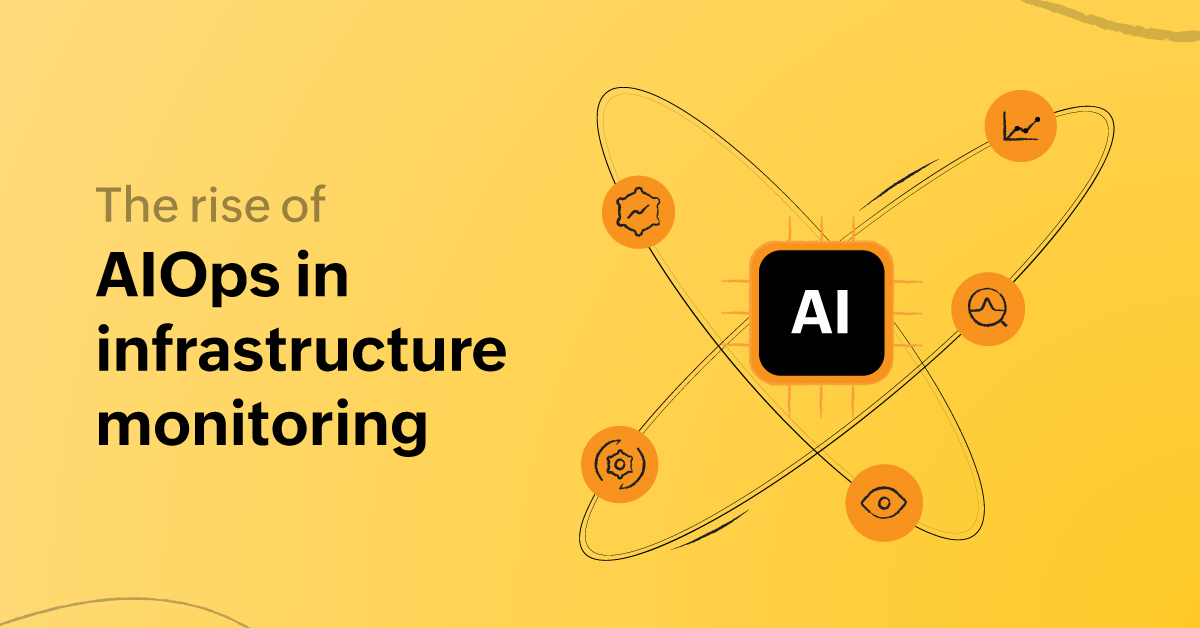The rise of AIOps in infrastructure monitoring

Drowning in data from complex environments? Ditch the reactive approach. Artificial intelligence for IT operations (AIOps) empowers proactive management with comprehensive observability. According to Gartner, IT spending will continue to mount sky-high despite the global economic instability; the IT expenditure is predicted to surge by 8.6% in 2024.
Manual monitoring often fails to keep up with the complexity of modern IT environments, leaving critical issues undetected. AIOps, like a squad of rescuers, helps transform the face of IT management by revolutionizing infrastructure monitoring.
What's the working principle of AIOps?
An AIOps platform steers clear of reactive alerts and enforces a proactive approach by leveraging machine learning and breaking down data silos, providing a comprehensive view of your IT environment. With this newfound situational awareness, AI can predict potential issues, automate personalized responses, and ensure that IT policies align with business goals. Essentially, AIOps empowers your IT team to become proactive guardians of your technology, preventing problems before they escalate into downtime.
In this blog, we will discuss how to leverage intelligent monitoring with AIOps and various aspects (such as anomaly detection, IT automation, capacity forecasting, event correlation, and root cause analysis) to build a proactive approach and handle monitoring challenges in your IT environment.
Address blind spots in complex environments
Modern IT setups are complex ecosystems that include on-premises infrastructures, multi-cloud deployments, virtual machines, and containers. Traditional monitoring tools struggle to provide a unified view across these diverse systems, leading to blind spots where critical performance issues or potential outages go unnoticed until they significantly impact operations.
Get comprehensive, in-depth visibility into all the layers and stacks of your IT, leaving no nook or cranny unmonitored. Correlate the events and metrics across all the components in your ecosystem in the event of an outage, compare and map the effect of performance lag from one KPI to another, and trace the root cause of downtime with a bird's-eye view of the entire infrastructure on a single pane.
Determine data deviations in your infrastructure with anomaly and outlier detection
The majority of businesses in the IT industry rely on reactive monitoring, resulting in decreased performance that is not easy to analyze manually. With the rise of AIOps models, IT teams are aiming for a more proactive approach. They detect outliers and compare them to historical performance benchmarks collected over the course of days, allowing them to predict and avert performance spikes. For instance, if a database exceeds the expected request count, you can orchestrate alerts notifying you about the threshold breach and automation allocating additional resources to handle the load, preventing a minor hiccup from taking root.
An anomaly detection tool finds deviations from established baselines, utilizing statistical analysis, machine learning, and pattern recognition techniques. An anomaly dashboard helps you detect abnormal metric values, identify drastic changes, and reduce the time it takes to troubleshoot your stack. Some applications can detect unusual network traffic, identify potential security breaches, and spot performance issues early. For example, AI can identify a sudden spike in network traffic that indicates a possible DDoS attack, allowing for immediate mitigation efforts.
Reduce alert fatigue in your infrastructure and automate fail-safes
Millions of daily application transactions generate alerts, causing a signal-to-noise ratio problem and alert fatigue, which make it difficult to identify critical issues. An AIOps platform aggregates operational data to group critical issues and understand their interdependencies by correlating events and detecting patterns in incidents and outages.
To stay ahead of potential problems, create automation profiles in advance to automatically act on detected issues in your infrastructure. An automated remediation tool uses rule-based automation, self-healing scripts, and AI-driven decision-making to resolve identified IT issues without human intervention. For instance, an automated remediation tool can automatically restart a failed database service to minimize downtime and maintain continuity.
Optimize infrastructure workloads and resources with capacity planning
Scalability is a constant challenge among organizations. Setbacks in optimizing capacity can cause butterfly effects in trying to optimize resource allocation, predict traffic spikes, and maintain seamless operations during high-demand periods, leading to huge revenue losses.
By analyzing historical data, an AIOps platform can predict traffic spikes and dynamically allocate cloud resources to maintain responsiveness. Machine learning models within AIOps platforms forecast the future demand and automate the scaling process, ensuring optimal performance and cost-efficiency. During high-demand periods like a sale or an online event, an AIOps platform scales up resources based on predictions and real-time traffic. It then scales down resources afterwards to reduce costs.
The future of infrastructure monitoring
AIOps is not just a trend; it's the future of infrastructure monitoring. By leveraging AI and machine learning, AIOps platforms enable IT teams to gain complete visibility, streamline operations, and proactively ensure optimal performance across their entire IT landscape.
Site24x7 offers a sophisticated approach to integrating AIOps into your IT environment. With Zia-powered, nuanced features like anomaly detection, capacity planning, trend forecasting, outlier detection, and anomaly scoring, you can elevate your infrastructure to deliver the best business outputs.
Comments (0)